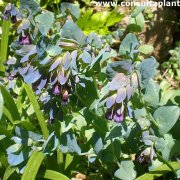Care of the plant Cerinthe major or Honeywort |
|
The genus Cerinthe, of the Boraginaceae family, comprises some 15 species of herbaceous plants originating in Central Europe and the Mediterranean basin. Some species of this genus are: Cerinthe major, Cerinthe minor, Cerinthe glabra, Cerinthe tenuiflora. Common name: Honeywort. This species is native to the Mediterranean region. They are branched annual plants of erect bearing that reach 1 meter (3.28 feet) in height. They are interesting for their oval-shaped bluish leaves and purple and yellow hanging flowers. They bloom in summer. Honeywort is used to form groups or borders and in pots for patios, terraces and balconies. It's an easy to grow plant ideal for low maintenance informal gardens. It's also used to make floral decorations. Cerinthe major needs exposure to full sun or light shade. It resists frosts down to -5 ºC (23 ºF) if the roots are dry; it tolerates intense heat very well. The soil must be well drained and contain organic matter. Water twice a week in summer (Mediterranean climate) and once a week the rest of the year. It prefers drought to excess water. Fertilize with compost in mid-fall. Cerinthe major does not need pruning. Honeywort is a quite resistant plant to the usual pests and diseases. Cerinthe major propagates by seeds sown in the final place in early spring. |
Images of the plant Cerinthe major or Honeywort |
Find plants
Cerinthe major or Honeywort | Care and Growing
© 2025 FavThemes



